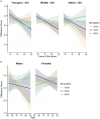The moderating effects of sex, age, and education on the outcome of combined cognitive training and transcranial electrical stimulation in older adults
- PMID: 37809311
- PMCID: PMC10556861
- DOI: 10.3389/fpsyg.2023.1243099
The moderating effects of sex, age, and education on the outcome of combined cognitive training and transcranial electrical stimulation in older adults
Abstract
Computerized cognitive training (CCT) has been shown to improve cognition in older adults via targeted exercises for single or multiple cognitive domains. Combining CCT with non-invasive brain stimulation is thought to be even more effective due to synergistic effects in the targeted brain areas and networks. However, little is known about the moderating effects of sex, age, and education on cognitive outcomes. Here, we investigated these factors in a randomized, double-blind study in which we administered CCT either combined with transcranial direct (tDCS), alternating (tACS) current stimulation or sham stimulation. 59 healthy older participants (mean age 71.7 ± 6.1) received either tDCS (2 mA), tACS (5 Hz), or sham stimulation over the left dorsolateral prefrontal cortex during the first 20 min of a CCT (10 sessions, 50 min, twice weekly). Before and after the complete cognitive intervention, a neuropsychological assessment was performed, and the test scores were summarized in a composite score. Our results showed a significant three-way interaction between age, years of education, and stimulation technique (F(6,52) = 5.53, p = 0.007), indicating that the oldest participants with more years of education particularly benefitted from tDCS compared to the sham group, while in the tACS group the youngest participants with less years of education benefit more from the stimulation. These results emphasize the importance of further investigating and taking into account sex, age, and education as moderating factors in the development of individualized stimulation protocols.
Clinical trial registration: ClinicalTrials.gov, identifier NCT03475446.
Keywords: age; cognitive training; education; older adults; sex; tACS; tDCS.
Copyright © 2023 Krebs, Peter, Brill, Klöppel and Brem.
Conflict of interest statement
The authors declare that the research was conducted in the absence of any commercial or financial relationships that could be construed as a potential conflict of interest.
Figures



Similar articles
-
Transcranial electrical stimulation improves cognitive training effects in healthy elderly adults with low cognitive performance.Clin Neurophysiol. 2021 Jun;132(6):1254-1263. doi: 10.1016/j.clinph.2021.01.034. Epub 2021 Mar 26. Clin Neurophysiol. 2021. PMID: 33875372
-
Cognitive and Neuropsychiatric Effects of 40 Hz tACS Simultaneously with Cognitive Exercises for Dementia: A Randomized, Crossover, Double-Blind, Sham-Controlled Study.Medicina (Kaunas). 2025 Apr 19;61(4):757. doi: 10.3390/medicina61040757. Medicina (Kaunas). 2025. PMID: 40283048 Free PMC article. Clinical Trial.
-
Transcranial direct current stimulation as an adjunct to cognitive training for older adults with mild cognitive impairment: A randomized controlled trial.Ann Phys Rehabil Med. 2021 Sep;64(5):101536. doi: 10.1016/j.rehab.2021.101536. Epub 2021 Jul 20. Ann Phys Rehabil Med. 2021. PMID: 33957292 Clinical Trial.
-
tACS as a promising therapeutic option for improving cognitive function in mild cognitive impairment: A direct comparison between tACS and tDCS.J Psychiatr Res. 2021 Sep;141:248-256. doi: 10.1016/j.jpsychires.2021.07.012. Epub 2021 Jul 6. J Psychiatr Res. 2021. PMID: 34256276
-
PsychotherapyPlus: augmentation of cognitive behavioral therapy (CBT) with prefrontal transcranial direct current stimulation (tDCS) in major depressive disorder-study design and methodology of a multicenter double-blind randomized placebo-controlled trial.Eur Arch Psychiatry Clin Neurosci. 2018 Dec;268(8):797-808. doi: 10.1007/s00406-017-0859-x. Epub 2017 Dec 6. Eur Arch Psychiatry Clin Neurosci. 2018. PMID: 29214483
Cited by
-
Development of a Cognitive Training Support Programme for prevention of dementia and cognitive decline in at-risk older adults.Front Dement. 2024 Feb 23;3:1331741. doi: 10.3389/frdem.2024.1331741. eCollection 2024. Front Dement. 2024. PMID: 39081598 Free PMC article.
-
Examining tolerability, safety, and blinding in 1032 transcranial electrical stimulation sessions for children and adolescents with neuropsychiatric and neurodevelopmental disorders.Sci Rep. 2025 Feb 7;15(1):4560. doi: 10.1038/s41598-025-88256-1. Sci Rep. 2025. PMID: 39915614 Free PMC article.
-
Associations Between Trail-Making Test Black and White Performance and Gray Matter Volume in Community-Dwelling Cognitively Healthy Adults Aged 40 to 80 Years.J Clin Med. 2025 Jun 7;14(12):4041. doi: 10.3390/jcm14124041. J Clin Med. 2025. PMID: 40565787 Free PMC article.
References
-
- Assecondi S., Hu R., Kroeker J., Eskes G., Shapiro K. (2022). Older adults with lower working memory capacity benefit from transcranial direct current stimulation when combined with working memory training: a preliminary study. Front. Aging Neurosci. 14:1009262. doi: 10.3389/fnagi.2022.1009262, PMID: - DOI - PMC - PubMed
-
- Bagattini C., Cid-Fernández S., Bulgari M., Miniussi C., Bortoletto M. (2023). Opposite pattern of transcranial direct current stimulation effects in middle-aged and older adults: behavioral and neurophysiological evidence. Front. Aging Neurosci. 15:1087749. doi: 10.3389/fnagi.2023.1087749, PMID: - DOI - PMC - PubMed
Associated data
LinkOut - more resources
Full Text Sources
Medical

